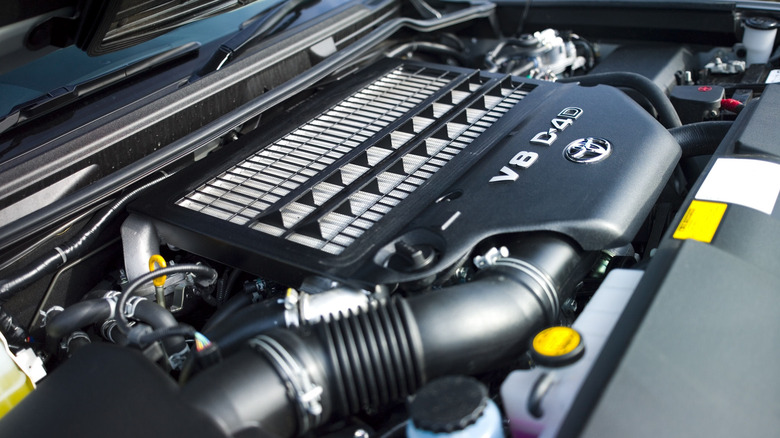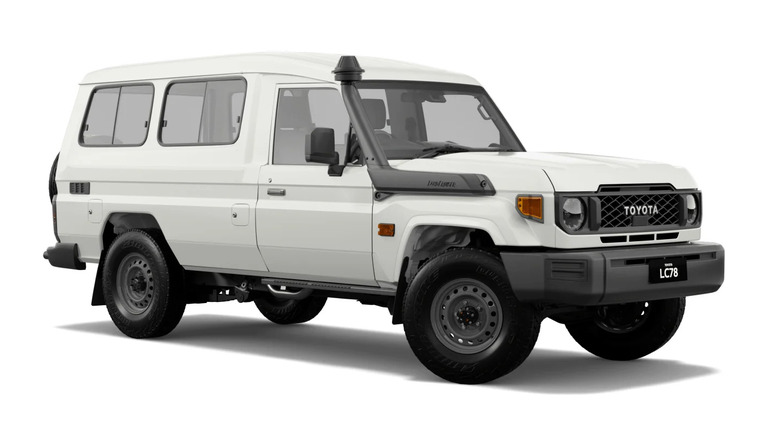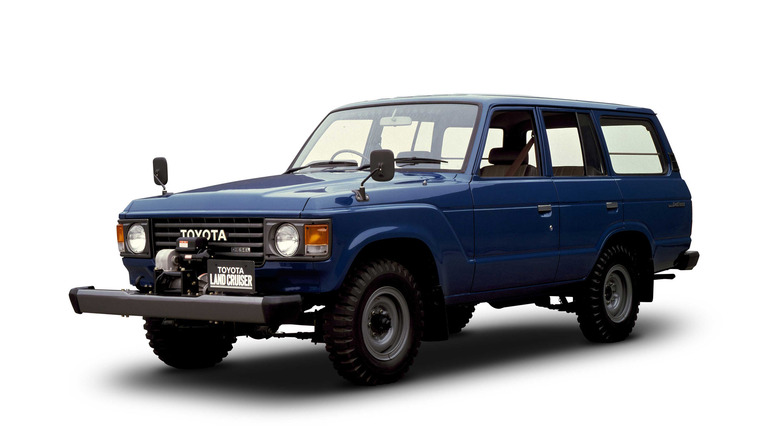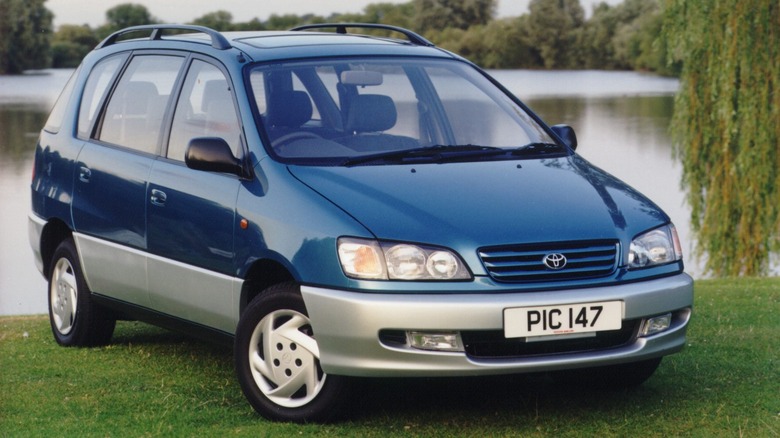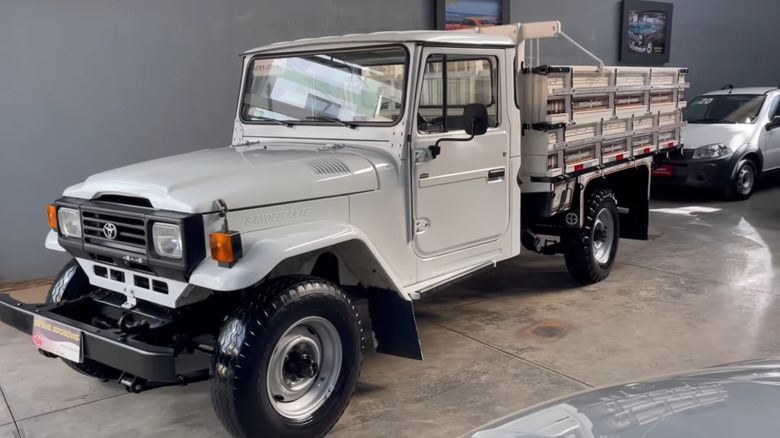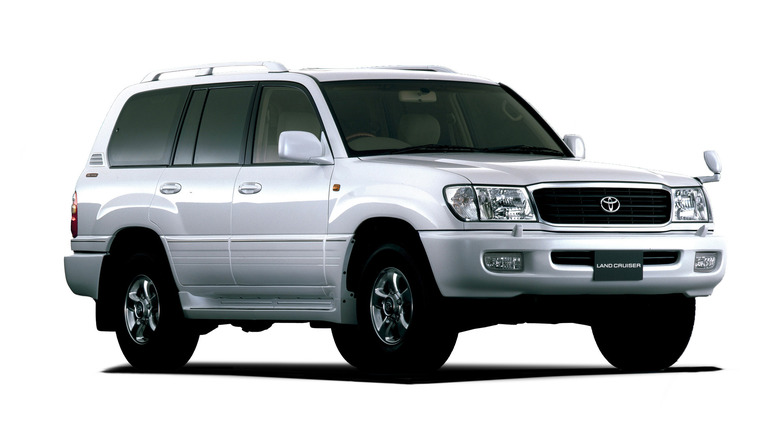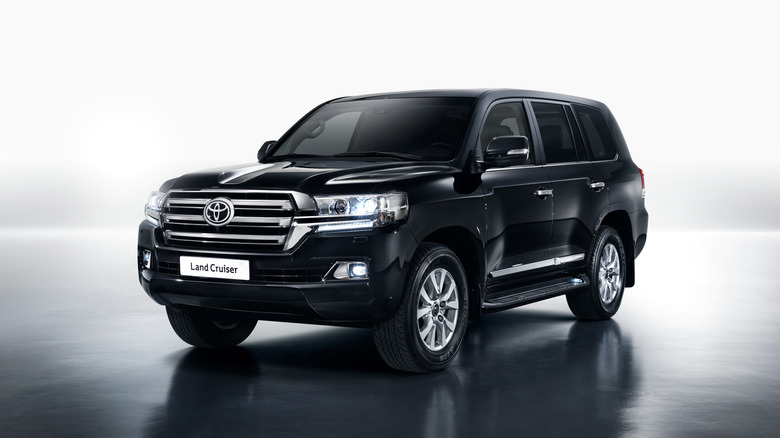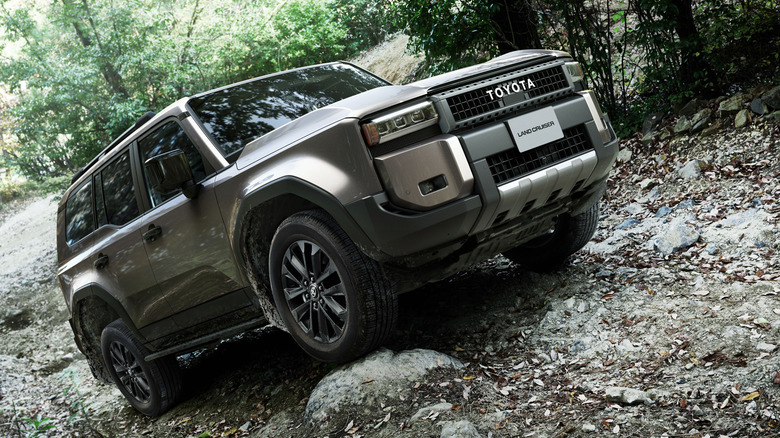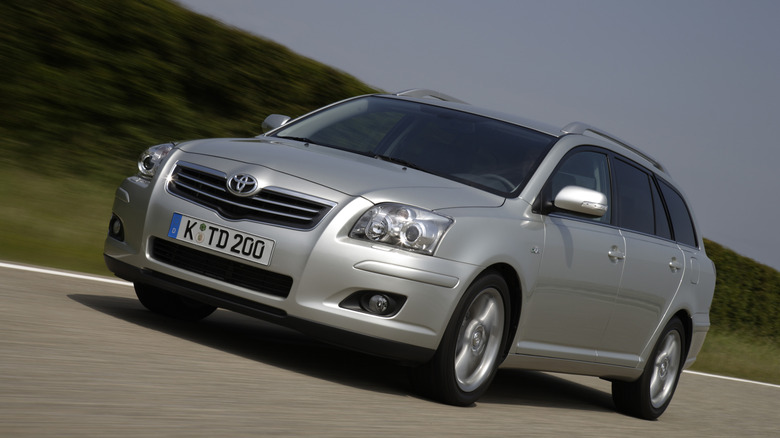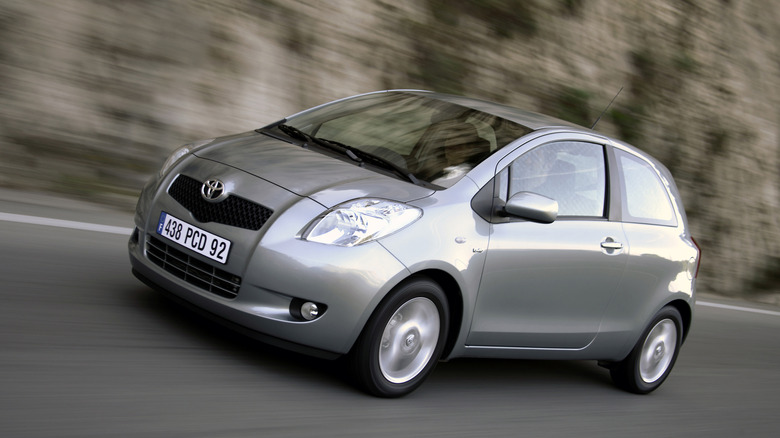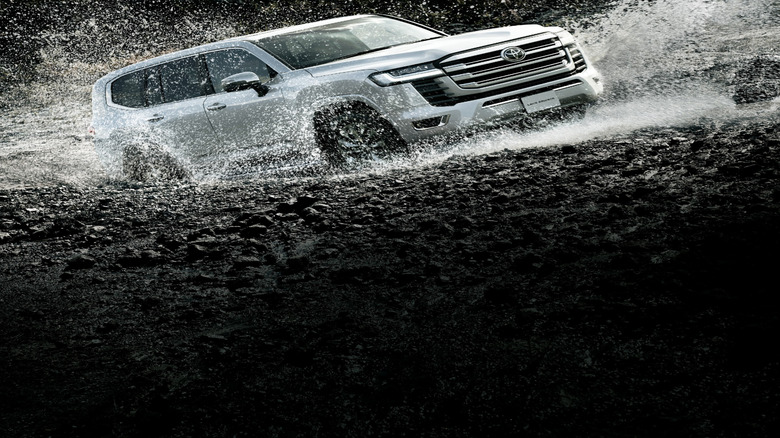10 Of The Best Diesel Engines Ever Built By Toyota
We may receive a commission on purchases made from links.
For the North American auto enthusiast, Toyota is synonymous with reliable gas and hybrid powertrains. Elsewhere, though, the world's largest automaker has been making some great diesel engines as well. Those Land Cruisers and Hiluxes you see crossing the world's harshest terrains? Powered by diesel. Even the latest Land Cruiser 250, which is sold as a hybrid in North America, is offered with a diesel engine in other markets. Not to mention, Toyota has sold numerous diesel-powered sedans, hatchbacks, and wagons in Europe in the last few decades.
So are there Toyota diesels that deserve the iconic status of their gas counterparts? There is no 2JZ equivalent in the diesel world, that I can assure you. However, some of the units listed here offer unrivaled durability and reliability — just what you'd want from a diesel. It is something I learned when I worked as an aftermarket manager at a Toyota dealership, where I encountered quite a few high-mileage Toyota diesel engines. Moreover, I've been writing about and reviewing cars for over 15 years and had first-hand driving experience with those engines. With that said, what follows is a list of the 10 best diesel engines ever built by Toyota!
Toyota 1HZ (1990 to Present)
The 1HZ is an SOHC, 4.2-liter inline-six engine with two valves per cylinder. It has indirect injection and no turbocharger, and due to its heavy cast-iron block, it weighs around 660 pounds. So, it's unsurprising that it produces only 129 hp and 210 lb-ft of torque. To make things even harder for the 1HZ, Toyota used it in the Land Cruiser 70 Series from 1990 to 2007, which weighs around 4,600 pounds. So, as you'd imagine, it is painfully slow, with a top speed of only 93 mph. Toyota didn't disclose a 0-60 time for obvious reasons, but from my experience, I'd say it's about 20 seconds.
So, what makes the 1HZ great, then? It's stupendously reliable and durable. Due to its simple construction, few things can go wrong on this 4.2-liter. No high-pressure common-rail pump means it works on low-quality fuel. No turbocharger means one less thing to worry about. Only the necessary essentials keep you going. The block and cylinder head are also made of cast iron, and the internals are overengineered for the power on offer.
Covering 300,000 miles before rebuilding is almost a given with the 1HZ, with some reaching over 600,000 miles! Thus, it's easily one of the most reliable JDM engines ever built. It's easy to repair, too, with 1HZ engine rebuild kits readily available online. The 1HZ is so popular among Land Cruiser purists that Toyota still sells it in some African countries with more lenient emission standards. The fact that the 1HZ earned its popularity in countries with the most challenging road infrastructure speaks volumes. If you want more power, aftermarket turbo kits are also readily available.
Toyota 2H (1980 to 1984)
The 2H is the predecessor to the 1HZ, and — as you'd expect — it is even more underpowered. It's a 4.0-liter non-turbo unit producing up to 107 hp at 3,500 rpm and 177 lb-ft of torque at 2,000 rpm. Thanks to its inline-six layout it's inherently balanced engine — surely smoother than its four-cylinder 3B predecessor. Its smoothness certainly suited the more luxurious Land Cruiser FJ60, which is among the best-looking Toyota SUVs ever made.
Like most diesel engines built for Land Cruisers, the 2H is also very durable, reliable, and easy to maintain. It will run on any diesel fuel, and its low rpm nature helps when off-roading. Still, if you want more power, turbo kits are readily available. They are not cheap and will reduce the motor's lifespan, but can bump its figures to 147 hp and 250 lb-ft of torque. Alternatively, you can go with the 12H-T, which is essentially the turbocharged version of the 2H. It makes 134 hp and 232 lb-ft of torque, though it's not as reliable as its naturally aspirated cousin.
Toyota 3C (1992 to 2007)
Toyota isn't only good at making diesel engines for its Land Cruiser SUVs, as the Japanese brand made quite a few diesels for passenger vehicles and vans. One of the early great examples is the 3C family. It consists of three 2.2-liter four-cylinder units made of a cast iron block and an aluminum cylinder head. The 3C-E serves as the entry-level, naturally-aspirated version with electronic fuel injection. It produces 79 hp and was mainly used in Toyota's JDM vans.
Interestingly, a turbocharged version, called the 3C-T, was available in the 1994 Toyota Camry in Japan. In the sedan, it produced 90 hp and was equipped with a Diesel Smoke Control System. The same engine also powered the Picnic, a reliable van we wish Toyota never discontinued.
Then, there is the turbocharged 3C-TE with electronic fuel injection, which was used in the Toyota Caldina wagon. In that car, it was the efficient option, as with 93 hp on offer it couldn't compete with the 3S-GTE turbocharged gas option. That said, the latter versions of the 3C-TE made healthy 105 hp and 166 lb-ft of torque.
Those numbers surely don't pique your interest, but like with most Toyota engines, the 3C's trump card is reliability. It's not as durable as the six-cylinder machines from past Land Cruisers, but still very tough for its category. This is especially true for the naturally aspirated variant, which is mostly trouble-free through its lifecycle. As a result, it's a popular swap for Jeeps in Asian countries.
Toyota 14B (1994 to 2001)
The 14B is the latest and greatest diesel of Toyota's long B lineage. However, don't let that fool you into thinking it's advanced by today's standards. It had direct injection, which was a big upgrade over the predecessor, but other than that, it's a fairly conservative affair.
You know what this means? Durability! This 3.7-liter inline-four has massive pistons and produces only 96 hp and 177 lb-ft of torque, so excellent reliability is to be expected. Unsurprisingly, Toyota used it in its one-ton DynaAce trucks, but the 14B was more popular for its presence in the Bandeirante pickup truck. Unfamiliar with it? It's a special version of the Land Cruiser FJ40 built in Brazil, albeit with different mechanical parts.
Compared to the FJ40, the Bandeirante had more modern engines, with the smooth and quiet 14B being the best on offer. Toyota paired it exclusively with a five-speed manual transmission in the Brazil-exclusive truck to extract as much performance as possible. Still, like with most tough Toyota diesel engines, the 14B responds well to turbocharging. Boosted or not, the Bandeirante is still a popular choice in Brazilian parts with next-to-no road infrastructure, either as an agricultural truck or an off-road adventure vehicle.
Toyota also made a factory turbocharged version, called the 14B-T, which produced 138 hp and 246 lb-ft of torque. However, the 14B-T was only available in JDM-only Dyna vans. Still, the 14B continued its life as a marine engine under Yamaha's brand, a testament to its versatility and reliability.
Toyota 1HD-FTE (1998 to 2002)
Toyota's lineage of excellent inline-six diesel engines culminated with the 1HD-FTE. Like its predecessors, this 4.2-liter turbocharged unit was made for the Land Cruiser — in this case, the luxurious 100 Series. Typical for any SUV engine from the brand, it's made from a stout high-strength cast-iron block and cast-iron cylinder head, giving it the toughness you'd expect from a Land Cruiser engine. However, the 1HD-FTE also has a forged crankshaft, strong carbon steel camshaft, seven forged journals, and twelve balance weights.
The 1HD-FTE succeeded the less powerful 1HD-T (164 hp) and 1HD-FT (168 hp). It came with a standard intercooler and direct electronic fuel injection (though still with an old-school mechanical pump), giving it 202 hp at 3,400 rpm and useful 317 lb-ft of torque available between 1,400 and 3,200 rpm. So — for the first time in Land Cruiser's history — owners could enjoy a diesel powertrain that was usable on the highway.
Although more powerful than its predecessors, the 1HD-FTE has proven to be more reliable as well, showing Toyota's continuous improvement over the years. In fact, the 1HD-FTE is so reliable, that Toyota also used an intercooler-less variant in the Land Cruiser 70 Series, which is more of an agricultural truck. The 1HD-FTE continues to be a popular option among Land Cruiser owners even today. It enjoys healthy aftermarket tuning support, with kits that can push it to around 400 hp – not bad for a two-decade-old turbodiesel.
Toyota 1VD-FTV (2007 to 2024)
The 1VD-FTV succeeded the 1HD-FTE in the lineage as Toyota's first-ever V8 turbodiesel engine. It's also the first turbodiesel engine with high-pressure common rail installed in a Land Cruiser, resulting in a significant power hike over the inline-six predecessor. Furthermore, the 1VD-FTV was equipped with four valves per cylinder, forged steel crankshaft, and high-strength steel connecting rods.
In the high-output twin-turbo version, the 1VD-FTV was equipped with two low-inertia turbochargers for higher responsiveness. The result was 282 hp and a massive 479 lb-ft of torque. As expected, the V8 gave the Land Cruiser a never-before-seen performance — the three-row SUV sprinted to 62 mph in 8.2 seconds and reached 131 mph. The excellent torque also gave the Land Cruiser 200 an impressive tow rating of over 7,700 pounds and a great highway fuel economy of 26 mpg.
The 4.5-liter V8 is one of the most influential engines in the Land Cruiser lineup not just because it was potent. Namely, despite being one of the most complex diesels Toyota has ever produced, it has shown to be very reliable and durable. That is particularly true for the single-turbo version found in the Land Cruiser 70 Series, which, to the dismay of enthusiasts, was just discontinued in September 2024. Toyota replaced it with a four-cylinder turbodiesel, making it an even harder pill to swallow for Land Cruiser aficionados.
Toyota 1GD-FTV (2015 to Present)
The great V8 turbodiesel might be gone, but don't go thinking the four-cylinder that replaced it in the 70 Series is bad. Quite the opposite, in fact. The 1GD-FTV is a modern, 2.8-liter turbocharged unit which has been the cornerstone of the Land Cruiser Prado and Hilux since 2015, replacing the larger 3.0-liter — and also great — 1KD-FTV engine.
It also graces the 70 Series with better economy and lower emissions, and the latest Land Cruiser 250. Yup, the same Land Cruiser hybrid that we deemed "better than the badge" is available in other countries with a turbodiesel. Despite having only four cylinders, the 1GD-FTV produces a healthy 204 hp in the 250, and the torque figure of 369 lb-ft is more impressive. That power is available at anywhere between 1,600 and 2,800 rpm, making it more usable for off-roading and towing. The 1GD-FTV is paired exclusively to an eight-speed automatic in the 250, though you can have it with a six-speed manual in the 70 Series.
The 1GD-FTV is a new engine, so it's too early to tell how long it will last. Still, from my experience at the official Toyota service, early results are promising, with customers already covering more than 150,000 miles without issues. The DPF (Diesel Particulate Filter) can be a problem according to some owners, but Toyota pushed a software upgrade to mitigate the issue. Overall, though, it's a stout unit designed to tackle the world's most challenging roads, just like every predecessor specifically made for the Land Cruiser.
Toyota 1CD-FTV (1999 to 2007)
At the turn of the millennium, there was a diesel craze in Europe. Due to their superior fuel economy, diesel-powered vehicles overtook gas cars in European markets. Toyota, a company that was before more associated with its gas engines in its smaller passenger vehicles, needed a quick response. So, it introduced the 1CD-FTV in 1999 — its first-ever diesel engine with common-rail direct injection.
The 1CD-FTV was a 2.0-liter turbocharged four-cylinder engine with four valves per cylinder, a cast iron block, and an aluminum cylinder head. It has proven reliable over the years, though not without issues. Still, most were remedied by Toyota over the years, either by engine upgrades or repairs. The issues I encountered the most were a leaky water pump (replacement necessary) and a faulty oil pressure sensor (replacement necessary), but other than that, it's a dependable unit. With proper maintenance, I've seen examples covering over 200,000 miles without major issues.
The 1CD-FTV was also pretty potent for the era. The most powerful version with a variable-geometry turbocharger made 116 hp and 207 lb-ft of torque, enough to bring the 2003 Avensis to a top speed of 121 mph while returning 42 mpg combined. The 2.0-liter was also ubiquitous in Toyota's passenger vehicles in the 2000s and also powered the Corolla, Corolla Verso, RAV4, Avensis Verso, and Previa.
Toyota 1ND-TV (2002 to 2018)
Toyota's diesel offensive in the 2000s continued with the 1ND-TV. This tiny 1.4-liter turbocharged diesel with common-rail fuel injection is one of the best small diesel engines Europe has ever seen. It was used in multiple small Toyota models, like the Yaris, Urban Cruiser, and later the Corolla/Auris. Toyota sold it until 2018 in Europe when Toyota killed all diesel powertrains for small passenger cars. The 1ND-TV was so popular that BMW also installed it in the Mini One from 2004 to 2006.
What made this engine so special is its exceptional fuel economy. Toyota offered the engine in two tunes – 74 hp and 89 hp. The less powerful engine, available in the first-gen Yaris, was good for an incredible 56 mpg combined, while the more powerful variant in the second-gen Yaris got 52 mpg. In my experience with a few company cars, these figures were easily achievable in the real world. What's more, with 140 lb-ft of torque, the 89 hp version was quite punchy for its size, even on the highway. It's quiet and refined, too.
The 1ND-TV wasn't without problems. A recall campaign solved an issue with an improperly tightened head and block, and some units experienced failed turbines for the first few years of production. However, Toyota significantly improved the engine through its 16-year presence on the market, and the latter versions were pretty reliable. In my experience, and that of many owners, the 1ND-TV has a lifespan of 180,000 to 250,000 miles, which is not bad for a small turbodiesel.
Toyota F33A (2021 to Present)
The F33A is the latest and greatest diesel engine from Toyota, launched with the latest Land Cruiser 300 and Lexus LX 500d. Oh, yes, the most luxurious Lexus off-roader is available with a diesel powertrain in some markets. It's a 3.3-liter twin-turbo V6 unit with a 90-degree angle between the cylinder banks. This is quite unusual, as V6s are usually built with a 60-degree angle.
Perhaps the origin of the F33A is the 1VD-FTV 4.5-liter V8 turbodiesel, as they also share the bore and stroke of 86.0 mm X 96.0 mm. However, the newer motor has steel pistons instead of aluminum, as they will be subjected to higher pressures from the common-rail injection system. Moreover, the F33A has front-mounted intercoolers to cool the intake air more efficiently.
As a result, the F33A is a true powerhouse of an engine. Yes, it's smaller than any other diesel in the Land Cruiser range, but with 305 hp and a whopping 516 lb-ft of torque available between 1,600 to 2,600 rpm, it's easily the most capable. Due to its smaller size, the F33A is also lighter than the V8 it replaced as well.
The F33A is exclusively available with a 10-speed automatic transmission in the Land Cruiser 300 and propels the SUV to 62 mph in just 6.9 seconds. Toyota promises a fuel economy of 26 mpg combined, which is impressive for the power on offer. As for durability, only time will tell whether the F33A follows in the footsteps of its predecessors.
